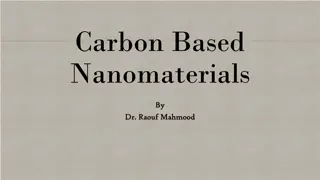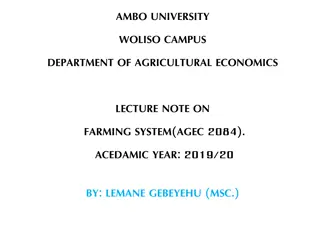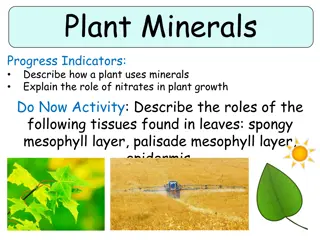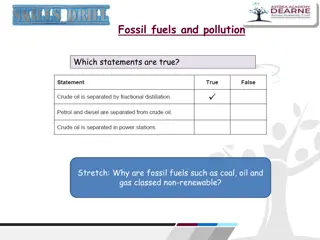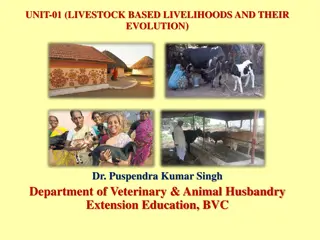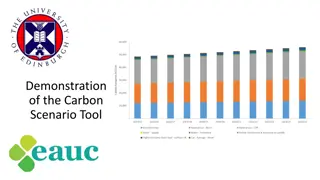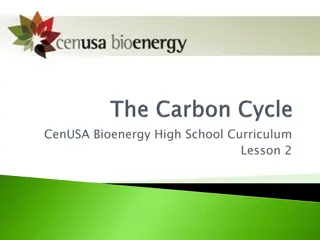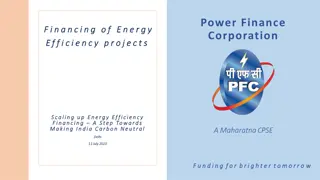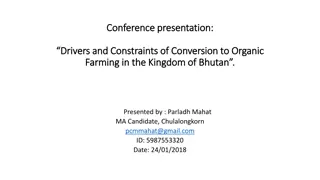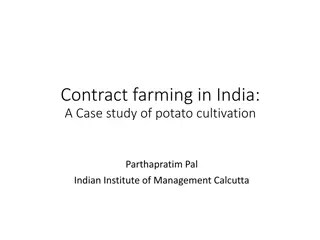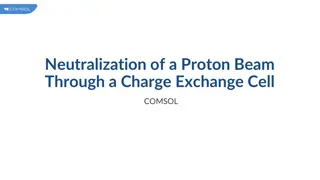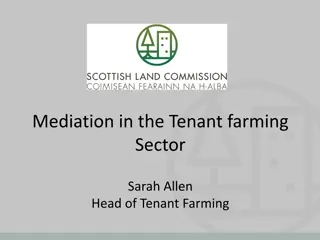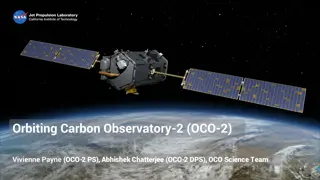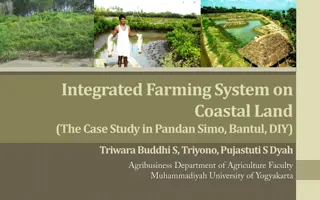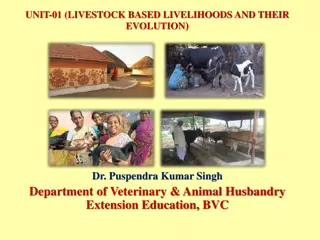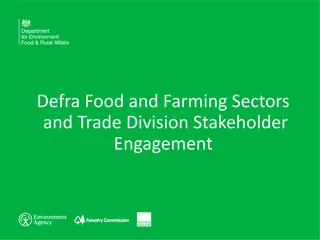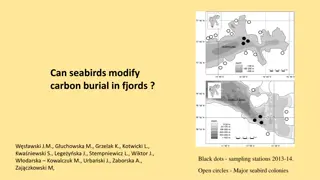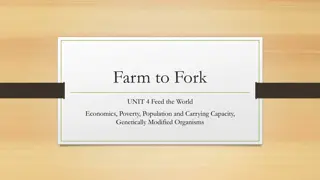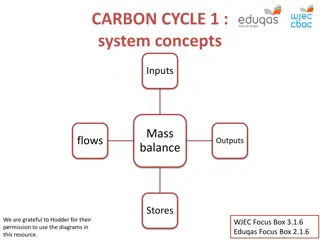Harnessing Carbon Markets for Sustainable Development in Pakistan
Understanding the significance of carbon markets, this content delves into the interplay between economic growth and environmental sustainability, emphasizing the urgency to limit unsustainable practices. It explores mechanisms such as carbon pricing and cap-and-trade systems in the context of clima
0 views • 17 slides
Carbon Pricing Overview and EU Green Deal Agenda
The overview of carbon pricing inside the EU highlights key aspects such as the EU Green Deal, revision of the EU ETS, and the Carbon Border Adjustment Mechanism. The EU aims for carbon neutrality by 2050 with a 55% reduction target. The Fit for 55 initiative emphasizes relevance for the Energy Comm
4 views • 16 slides
Ensuring Integrity in the Voluntary Carbon Market for a Just Transition
The voluntary carbon market plays a crucial role in achieving a just transition to 1.5°C, emphasizing high integrity standards. The ICVCM has set Core Carbon Principles to uphold quality standards for carbon credits, ensuring market integrity and participant eligibility. Key components include asse
1 views • 18 slides
Overview of California's Carbon Removal Initiatives
California's Carbon Removal Innovation Support Program (CRISP) aims to incentivize Direct Air Capture (DAC) development in the state. The program includes research test centers, small-scale demonstrations of DAC technologies, community engagement, technical assistance, and more to enhance carbon rem
0 views • 5 slides
Understanding the Carbon Cycle: Reservoirs, Dynamics, and Importance
Earth's carbon cycle plays a crucial role in sustaining life, with carbon moving through various reservoirs and processes. This cycle involves short-term terrestrial and marine cycles, as well as long-term cycles influenced by volcanic activity and rock weathering. Understanding carbon reservoir dyn
6 views • 45 slides
Embracing Sustainability: A Comprehensive Analysis of Carbon Neutral Farming
Carbon Neutral Farming Market, also known as carbon farming or climate-smart agriculture, focuses on reducing greenhouse gas emissions and sequestering carbon in soils and vegetation.
3 views • 2 slides
Understanding Carbon-Based Nanomaterials and Their Technical Applications
Carbon-based nanomaterials, including fullerenes and carbon nanotubes, have revolutionized various industries with their unique properties. These materials, classified based on their geometrical structure, have applications in fields such as electronics, gas storage, biotechnology, and more. Fullere
0 views • 12 slides
Understanding Farming Systems in Agricultural Economics
Concepts of farming systems research and development are crucial for effective agricultural management. A farming system encompasses various components that work together to achieve specific objectives. It involves the arrangement and management of farming enterprises in response to environmental fa
0 views • 49 slides
Tracing Carbon Atoms in Ecosystems: Understanding the Organic Matter Pyramid
Explore the journey of 500 carbon atoms through producers, herbivores, and carnivores in an ecosystem. Discover how carbon atoms move through photosynthesis, cellular respiration, and biosynthesis, ultimately contributing to the organic matter pyramid. Follow the pathways of carbon atoms as they cyc
0 views • 7 slides
Organic vs Conventional Farming: An Overview
In the debate between organic and conventional farming, both methods have their pros and cons. While organic foods are perceived to follow stricter safety standards, both types meet FDA and USDA regulations. They offer similar nutritional value, but organic farming tends to have lower efficiency due
0 views • 6 slides
Plant Minerals and Farming Methods
Learn about how plants use minerals for growth, the role of nitrates, different leaf tissues, mineral deficiencies, and farming methods to ensure crop yield. Discover how plants obtain minerals from the soil, symptoms of mineral deficiencies, and the importance of fertilizers in farming. Explore dif
0 views • 13 slides
Understanding Fossil Fuels and Pollution: A Comprehensive Overview
Fossil fuels such as coal, oil, and natural gas are non-renewable energy sources that release heat energy when burned, but also contribute to pollution when not burned completely. This leads to the release of harmful pollutants like carbon dioxide, carbon monoxide, sulfur dioxide, and carbon particu
2 views • 9 slides
Diverse Methods of Poultry Farming and Agricultural Practices
Poultry farming practices such as organic farming, nitrogen fixation, biodiversity management, and contract farming are discussed. Organic farming emphasizes holistic relationships in agriculture, promoting sustainable production. Nitrogen fixation and biodiversity management play essential roles in
0 views • 20 slides
Evolution of Livestock-based Livelihoods and Capitalistic Farming Systems
Livestock-based livelihoods have evolved over time, with capitalistic farming systems emerging as prominent in regions like South America, North America, and Europe. These systems are characterized by individual entrepreneurs controlling farming activities. Plantations are a common example of capita
0 views • 10 slides
Livestock-based Livelihoods and Farming Systems Evolution
Livestock-based livelihoods and farming systems have evolved over time, aiming to produce food and crops sustainably. Small-scale farming, farm management, types of farming, and various farming systems like specialized and diversified farming play key roles in enhancing productivity, profitability,
9 views • 19 slides
Understanding the Carbon Scenario Tool for Climate Change Management
The Carbon Scenario Tool (CST) is a valuable resource developed by the University of Edinburgh and the Scottish Funding Council to manage, report, and forecast carbon emissions for university estates and operations. It enables the calculation of the impact of carbon reduction projects and the develo
2 views • 18 slides
Contract Farming in India: A Case Study of Potato Cultivation
Value addition in Indian agriculture is low due to poor processing levels. Contract farming is being considered to integrate agriculture production into the global value chain, but concerns about unequal bargaining power between farmers and corporations exist. Various forms of contract farming exist
0 views • 26 slides
Understanding Carbon Movement in the Environment
Explore the intricate processes of carbon movement in the biosphere, atmosphere, oceans, and geosphere. Learn how plants absorb carbon dioxide, animals utilize carbon for tissue building, and the impacts of human activities like burning fossil fuels on carbon distribution. Discover the critical role
0 views • 6 slides
Power Finance Corporation: Leading Energy Efficiency Financing for a Carbon-Neutral India
Power Finance Corporation (PFC) is a financial powerhouse specializing in funding energy efficiency projects to make India carbon neutral. Established in 1986, PFC is a key player in the power sector, funding a wide range of projects from power generation to environmental initiatives. With a strong
0 views • 21 slides
Exploring Drivers and Constraints of Conversion to Organic Farming in Bhutan
Population in Bhutan heavily relies on agriculture, but the transition to organic farming has been slow despite the desire to reduce chemical use. This presentation investigates the current state of organic farming, identifies key factors affecting conversion, and offers policy recommendations to pr
0 views • 22 slides
Understanding Organic Chemistry: Carbon Atoms and Molecular Diversity
In organic chemistry, carbon atoms can form diverse molecules by bonding to four other atoms, leading to molecular complexity and diversity. The versatile nature of carbon allows for the formation of various carbon skeletons, contributing to the vast array of organic compounds. Hydrocarbons, consist
0 views • 12 slides
Innovative CPC Futures Contract Program for Agribusiness Sustainability
The Commodity Plus Carbon (CPC) Futures Contract Program integrates agricultural commodity prices with carbon valuation to incentivize good agricultural practices and reduce carbon footprint. By combining ag commodity prices with carbon reductions, CPC contracts offer hedging opportunities and incen
0 views • 8 slides
Agricultural Practices and Major Crops in India
India is predominantly an agricultural-based country with two-thirds of its population engaged in farming. The country practices different types of farming, including primitive subsistence farming, intensive subsistence farming, and commercial farming. The cropping seasons in India are classified as
0 views • 8 slides
Contract Farming in India: Enhancing Agricultural Value Chain Through Partnerships
Value addition in Indian agriculture has been low due to limited processing levels. Contract farming is emerging as a viable solution to integrate agriculture production into the global value chain, albeit with concerns about unequal bargaining power. Various forms of contract farming exist, with ex
0 views • 26 slides
Understanding Carbon Storage in Biomes and Ecosystems
Explore the intricate carbon cycle within terrestrial ecosystems, focusing on carbon storage in biomass, litter, and soil. Delve into the differences in plant characteristics among various biomes and their impact on carbon sequestration. Gain insights into the distribution of tropical rainforests an
0 views • 13 slides
Integrated Terrestrial-Coastal Ocean Framework for Carbon Management
An advanced framework integrating terrestrial and coastal ocean observations and modeling is developed to support carbon management decisions. The study focuses on assessing the impacts of land use, human activities, and climate scenarios on the carbon cycle, particularly dissolved inorganic carbon
0 views • 5 slides
Understanding Neutralization of Proton Beam Using Charge Exchange Cell in COMSOL
In various applications, collisions of neutral particle beams with target materials play a crucial role. This process involves neutralizing high-velocity proton beams by passing them through a charge exchange cell filled with neutral gas, such as argon. The cell allows protons to capture electrons f
0 views • 17 slides
Neutralization of Proton Beam Through Charge Exchange Cell
Collisions between neutral particle beams and target materials at varying projectile energies play a crucial role in numerous applications. Charge exchange cells facilitate the generation of high-velocity neutral particles by neutralizing fast ions within a high-density gas region. By capturing elec
0 views • 15 slides
Achieving UK Net-Zero: Strategies for Carbon Capture and Low-Carbon Fuels
Explore the pathways to achieving UK net-zero carbon emissions through carbon capture, low-carbon alternative fuels like hydrogen and bioenergy, and sustainable bioenergy practices. Learn about the importance of zero-carbon hydrogen production and the challenges and benefits of utilizing bioenergy f
0 views • 12 slides
Enhancing Mediation in the Tenant Farming Sector
Sarah Allen, Head of Tenant Farming, leads initiatives to promote mediation in the tenant farming sector, aiming to improve relationships between landlords and tenants. The Tenant Farming Commissioner under the Land Reform Act 2016 encourages mediation for resolving complex disputes. The pilot media
0 views • 9 slides
Mapping Soil Organic Carbon Fractions in Australia: Stocks and Uncertainty
This study by Mercedes Román Dobarco et al. focuses on mapping soil organic carbon fractions across Australia, including mineral-associated organic carbon, particulate organic carbon, and pyrogenic organic carbon. The research involves prediction of soil organic carbon fractions using spectral libr
0 views • 17 slides
Carbon Forestry and Poverty Alleviation: The Case of REDD in Nigeria
Global carbon forestry programs like REDD aim to alleviate poverty but face challenges in empowering forest-dependent communities. The paper discusses the role of key actors in maintaining the status quo, presenting research findings from a REDD program in Nigeria. Carbon forestry involves market-ba
0 views • 15 slides
Insights from Orbiting Carbon Observatory-2 (OCO-2) on Global Carbon Cycle
Orbiting Carbon Observatory-2 (OCO-2) offers precise measurements to understand sources and sinks of CO2 in the atmosphere, providing valuable data on carbon uptake by plants and global carbon emissions. OCO-2's findings shed light on the impact of extreme climate events like droughts and fires on t
0 views • 8 slides
Integrated Farming System on Coastal Land: A Case Study in Pandan Simo, Bantul, DIY
The coastal area in Pandan Simo, Bantul, is embracing integrated farming systems combining food crops, horticulture, and livestock due to diminishing agricultural land. Farming on marginal lands like beaches has become a prevalent alternative. This case study aims to assess farming feasibility and r
0 views • 10 slides
Evolution of Livestock-Based Livelihoods: From Estate Farming to Specialized Crop Cultivation
Estate farming, a form of industrialized agriculture introduced by the British in the 19th century, involves large monocultures of cash crops like tea, rubber, and spices. It requires significant investment in modern farming techniques, machinery, and skilled labor. Estate farming is capital-intensi
0 views • 8 slides
Study on Climate Change and Organic Farming Impact by Madhyanchal Forum
Madhyanchal Forum conducted a study on the impact of climate change on agriculture and the effectiveness of organic farming in mitigating climate change. The study involved various organizations and farmers across different regions, focusing on the adoption of sustainable farming practices. Detailed
0 views • 16 slides
Sustainable Farming Incentive Stakeholder Engagement Meeting
The meeting hosted by Defra's Food and Farming Sectors and Trade Division aims to gather feedback on the Sustainable Farming Incentive pilot standards and payment processes. Stakeholders in the Arable Sector can provide expert input to shape the development of the program, ensuring farmers' active p
0 views • 20 slides
Carbon Modification by Seabirds in Fjords: Implications and Patterns
The study investigates the impact of seabirds on carbon burial in fjords, showcasing factors such as wind stress patterns, terrestrial vegetation biomass, and various carbon sources in the ecosystem. It delves into the distribution and fate of carbon in two fjords, Hornsund and Kongsfjorden, sheddin
0 views • 7 slides
Sustainable Agriculture: Feeding the World and Future Farming Practices
Explore the dynamics of farming from rural to urban settings, understanding factors like supply and demand, seasonal eating, and sustainable agriculture practices through the lens of economic, poverty, and population considerations. Discover how different farming practices meet market demands, how r
0 views • 55 slides
Understanding the Carbon Cycle: System Concepts and Pathways
The carbon cycle involves the movement of carbon between different stores in the global system, such as the atmosphere, oceans, and biosphere. Flows, inputs, and outputs play crucial roles in this cycle, with processes like photosynthesis and respiration impacting carbon levels. Explore how mass bal
0 views • 13 slides






